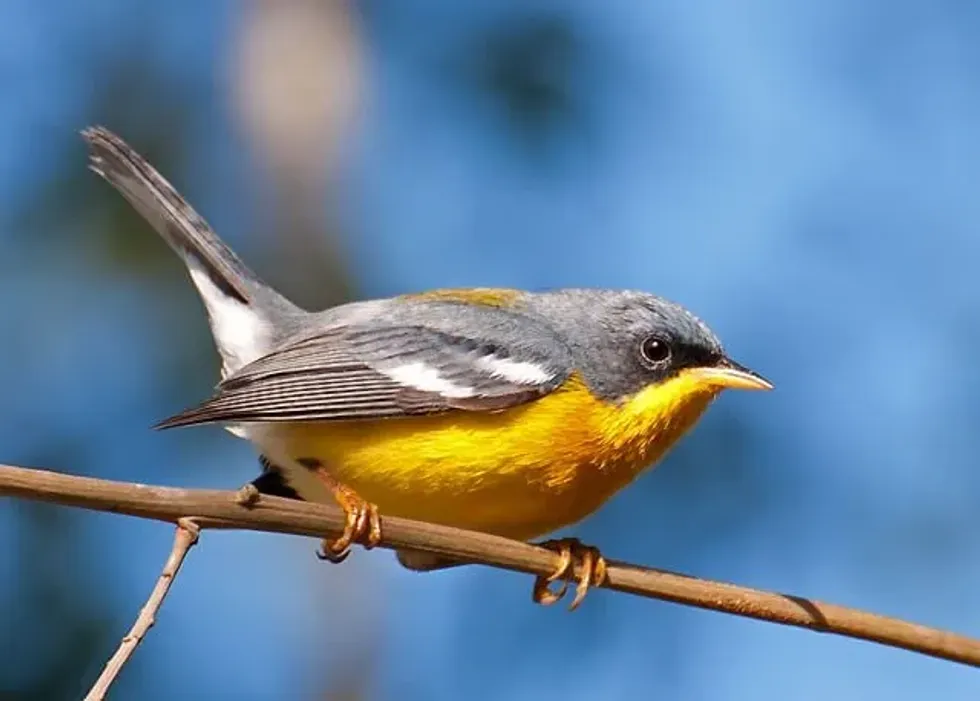The tropical parula (Setophaga pitiayumi) is a kind of warbler native to North and South America, including the region of Central America. These birds are found in Texas, Mexico, Suriname, Brazil, Argentina, and so on. They are a part of the Parulidae family and have been categorized into several subspecies.
These birds have a blue-gray and yellow plumage, with certain differences in appearance between male and female birds. They are found very commonly in most of their range in different forest ecosystems.
The tropical parula song is quite distinct and can be heard throughout the day in places where they reside. Tropical parulas build their nest in trees with Spanish moss and ball moss.
The breeding season varies in different populations. In Texas, some populations can only be found during the breeding season as they migrate south during the winter.
This species has the status of Least Concern under the Red List of the International Union for Conservation of Nature or IUCN. However, they do face some threats like air pollution and the use of pesticides which hamper their nest-making.
To know more about the tropical parula bird, keep reading! You can also check out snow bunting and fox sparrow.`
Tropical Parula Interesting Facts
What type of animal is a tropical parula?
Tropical parulas are birds. They are a small warbler species endemic to North and South America. They are considered to be New World warblers. Other species of warbler include willow warbler and hooded warbler.
What class of animal does a tropical parula belong to?
A tropical parula (Setophaga pitiayumi) belongs to the class Aves. This bird is a part of the order Passeriformes and the family Parulidae. Tropical parulas are further divided into several subspecies.
How many tropical parula are there in the world?
Fortunately, tropical parulas are fairly widespread and common in their range. Their population constitutes 20 million adult birds.
However, according to the International Union for Conservation of Nature or IUCN, these birds have a decreasing population range. For example, along the Rio Grande, these birds have become quite rare. The regions adjacent to the Rio Grande were a common nest site for tropical parulas.
Where does a tropical parula live?
The geographic range of tropical parulas constitutes both North and South America. In North America, they can be found in southern Texas and north-western Mexico.
In Central America, some of their locations are parts of Honduras, Guatemala, and Nicaragua. In South America, their range includes Guyana, Suriname, northern Brazil, northern Argentina, and north-western Peru.
Some populations of these birds can mostly be found in southern Texas during the breeding season as they get an abundance of Spanish moss there, used for nesting. During winter, much of the northern population migrates south.
What is a tropical parula's habitat?
The main habitat of this bird is forests with tall trees and sufficient presence of epiphytes like the Spanish moss, among which they make their nest. The different types of forests inhabited by tropical parulas are deciduous forest, humid submontane forest, lower montane forest, or secondary forest.
They can also be found in forest edges. In western Mexico, this species can be found in any scrub habitat.
Who do tropical parulas live with?
Tropical parulas are known to forage in small groups with birds from their own species and other species. Such groups can have up to 20 members. Wintering is also carried out in flocks of mixed species. The ones who form pairs can be seen with their partner throughout the year.
How long does a tropical parula live?
The lifespan of these small warblers is not known. However, the longest recorded lifespan of the northern parula bird, which is another species under the genus Setophaga and very closely related to the tropical parulas, is seven years.
How do they reproduce?
The breeding season in these birds varies depending on their location and range. Males have distinct songs as part of their mating display. Their nesting is done in epiphytes like Spanish moss and ball moss found in trees. The nest is built 6.5-42.6 ft (2-13 m) off the ground by the female bird and has a side entrance.
These warblers lay two to five eggs which are white with markings. Eggs are incubated for 12-14 days by the female bird. Both sexes participate in feeding the young birds.
What is their conservation status?
The conservation status of the tropical parula bird has been marked as Least Concern by the International Union for Conservation of Nature or IUCN. These birds are not under any direct threat of endangerment. However, the use of pesticides and air pollution harms the growth of epiphytes like the Spanish moss, which in turn affects their nesting.
Tropical Parula Fun Facts
What do tropical parulas look like?
The plumage of the male bird of this species has blue-gray upper parts and yellow and white underparts with an orange tone on the lower throat and upper breast. They also have white wing bars. Females, on the other hand, have a duller plumage with a lack of orange tone on the breast region.
They also lack black feathers around the eye. Both their tails have patches of white. Young tropical parulas are similar to the female.
How cute are they?
These birds are quite cute in appearance. Their cuteness is further enhanced by their range of songs.
How do they communicate?
Tropical parulas mainly communicate through songs and calls. Interestingly, male birds of this species, particularly in the northern range, have first and second-category song types which have some differences between them.
Males use their songs during the breeding season to attract mates. Generally, the calls of these birds sound like a buzzy trill resembling 'tsit' notes. In their southern range, the tropical parula song is more complex.
How big is a tropical parula?
The length of a tropical parula (Setophaga pitiayumi) is between 4.2-4.4 in (10.8–11.4 cm). These birds are almost the same size as a species of North American birds known as the Northern parula (Setophaga americana) which have a length of 4.3-4.7 in (11-12 cm).
How fast can a tropical parula fly?
The flight speed of the tropical parula is not known. However, their flight is described as weak and resembles fluttering.
How much does a tropical parula weigh?
Tropical parulas are a small warbler species and do not weigh much. The weight of a tropical parula is between 0.2-0.3 oz (6.5-8 g).
What are the male and female names of the species?
Male and female birds of this species are known as male tropical parulas and female tropical parulas, respectively.
What would you call a baby tropical parula?
A baby tropical parula is known as a chick.
What do they eat?
These birds have an omnivorous diet and mainly rely on insects and occasionally plant materials like berries. Some of the common insects they feed on are wasps, caterpillars, flies, and bees. They tend to forage for insects on twigs and branches.
Are they dangerous?
These small warbler birds are not considered to be dangerous.
Would they make a good pet?
The tropical parula is protected under the Migratory Bird Treaty Act of the United States and cannot be kept as pets in the country.
Did you know...
Tropical parula birds resemble northern parula birds very closely, and both birds were considered to be the same species before genetic data proved otherwise. These two species can be differentiated based on the absence of white eye crescents in tropical parulas.
How to tell a male and female tropical parula bird apart?
In this species, males and females both primarily have blue-gray and yellow plumage. However, the former appears a lot brighter than the latter. Female birds also lack the orange breast and black feathers around the eye, seen in the male.
Do tropical parula migrate?
Unlike Blackburnian warblers, tropical parulas are not considered to be a migratory warbler species as a whole. However, some populations do display local migration. The birds residing in the north tend to migrate to the south during winter.
Some of the birds fly from Texas to Mexico, whereas others may spend the winter in Texas without any migration. Some populations migrate to the lower Rio Grande valley to spend their winter. Dispersal is also noted in some birds after breeding.
Here at Kidadl, we have carefully created lots of interesting family-friendly animal facts for everyone to discover! Learn more about some other birds from our red-tailed hawk facts or jackdaw facts pages.
You can even occupy yourself at home by coloring in one of our free printable tropical parula coloring pages.










